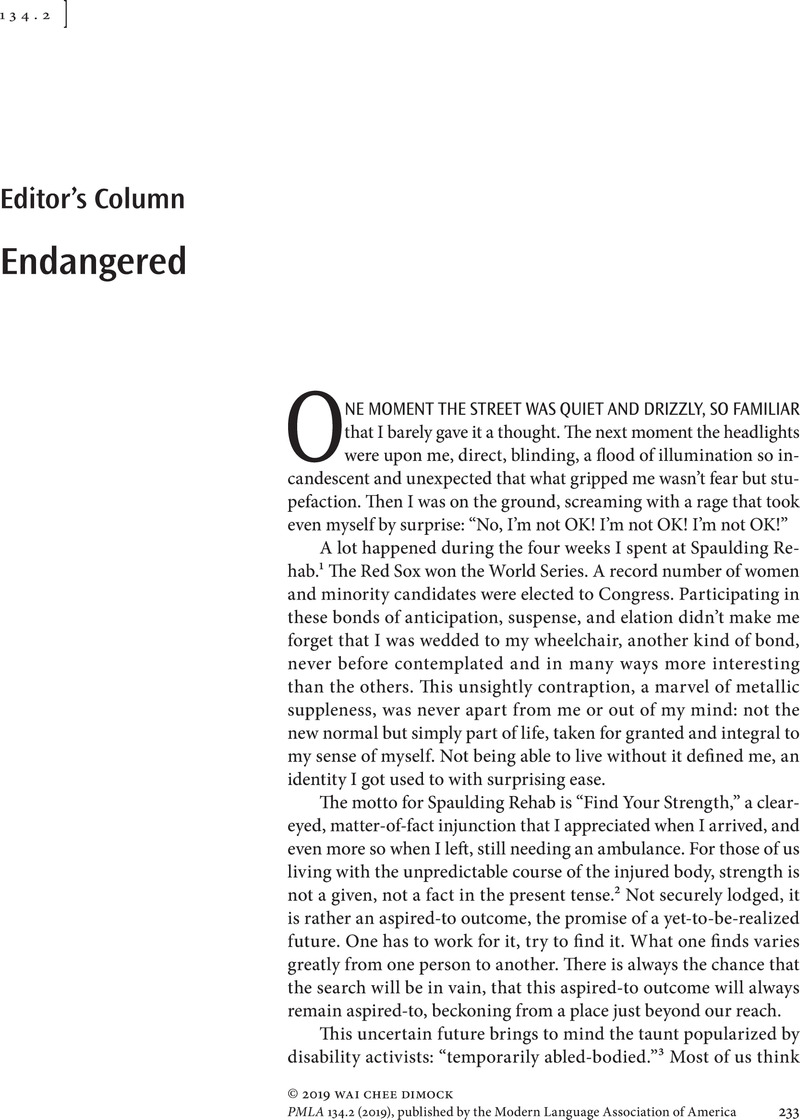No CrossRef data available.
Article contents
Editor's Column–Endangered
Published online by Cambridge University Press: 23 October 2020
Abstract
An abstract is not available for this content so a preview has been provided. As you have access to this content, a full PDF is available via the ‘Save PDF’ action button.

- Type
- Editorial
- Information
- Copyright
- Copyright © Modern Language Association of America, 2019
References
Works Cited
“About Narrative Medicine”. Narrative Medicine, Columbia University, 2019, www.narrativemedicine.org/about-narrative-medicine/.Google Scholar
Akyeampong, Emmanuel, et al., editors. The Culture of Mental Illness and Psychiatric Practice in Africa. Indiana UP, 2015.Google Scholar
Beek, Terra Scarlette. “To the patient in the blue gown in room 74.” The Health Humanities Journal, p. 10, hhj.web.unc.edu/journals/fall-2018/.Google Scholar
Brown, Brené. “How Vulnerability Can Make Our Lives Better.” Interview by Dan Schawbel, Forbes, 21 Apr. 2013, www.forbes.com/sites/danschawbel/2013/04/21/brene-brown-how-vulnerability-can-make-our-lives-better/.Google Scholar
Brown, Brené. “The Power of Vulnerability”. YouTube, 3 Jan. 2011, www.youtube.com/watch?v=iCvmsMzlF7o.TEDtalk.Google Scholar
Broyard, Anatole. Intoxicated by My Illness and Other Writings on Life and Death. Ballantine Books, 1992.Google Scholar
Chakrabarty, Dipesh. “The Climate of History: Four Theses”. Critical Inquiry, vol. 35, no. 2, 2009, pp. 197–222.CrossRefGoogle Scholar
Charon, Rita. “2018 Jefferson Lecture in the Humanities with Dr. Rita Charon”. YouTube, 18 Oct. 2018, www.youtube.com/watch?v=7yI0rdQEAj8.Google Scholar
Charon, Rita, et al. Principles and Practice of Narrative Medicine. Oxford UP, 2016.CrossRefGoogle Scholar
DasGupta, Sayantani. “Narrative Humility”. The Lancet, 22 Mar. 2008, www.thelancet.com/journals/lancet/article/PIIS0140-6736(08)60440-7/fulltext.Google Scholar
“Disability-Themed Emojis Approved for Use”. BBC News, 6 Feb. 2019, www.bbc.com/news/technology-47144091.Google Scholar
“Dr. Rita Charon Named the 2018 Jefferson Lecturer in the Humanities”. National Endowment for the Humanities, 4 Sept. 2018, www.neh.gov/news/dr-rita-charon-named-2018-jefferson-lecturer-humanities.Google Scholar
“Fact Sheet on Persons with Disabilities.” United Nations Enable, www.un.org/disabilities/documents/toolaction/pwdfs.pdf.Google Scholar
Fox, Ann. “Adaptive Activism: Teaching Graphic Medicine as Disability Studies.” Comics as Access: Learning Graphic Medicine Lightning Talks. Comics and Medicine Conference, 17 June 2017, Seattle Public Library Central Branch.Google Scholar
Fox, Ann. “Imagining Modern Bodies: Disability and Art at the Bechtler Museum of Modern Art”. YouTube, 24 Jan. 2013, www.youtube.com/watch?v=ORDGgKZKLqs.Google Scholar
Garland-Thomson, Rosemarie. Extraordinary Bodies: Figuring Physical Disability in American Culture and Literature. Columbia UP, 1997.Google Scholar
Haraway, Donna J. Staying with the Trouble: Making Kin in the Chthulucene. Duke UP, 2016.CrossRefGoogle Scholar
“Humanities at Penn State College of Medicine.” Penn State College of Medicine, 2019, med.psu.edu/humanities.Google Scholar
Jones, David Shumway. Rationalizing Epidemics: Meanings and Uses of American Indian Mortality since 1600. Harvard UP, 2004.Google Scholar
Jones, Therese, et al. “The Almost Right Word: The Move from Medical Humanities to Health Humanities.” Academic Medicine, vol. 92, no. 7, July 2017, pp. 932–35.CrossRefGoogle Scholar
Klugman, Paul. “How Health Humanities Will Save the Life of the Humanities”. Journal of Medical Humanities, vol. 38, no. 4, Dec. 2017, pp. 419–30.CrossRefGoogle Scholar
Krisberg, Kim. “Narrative Medicine: Every Patient Has a Story.” AAMCNews, Association of American Medical Colleges, 28 Mar. 2017, news.aamc.org/medical-education/article/narrative-medicine-every-patient-has-story/.Google Scholar
McRuer, Robert. Crip Theory: Cultural Signs of Queerness and Disability. New York UP, 2006.Google Scholar
McRuer, Robert. Crip Times: Disability, Globalization, and Resistance. New York UP, 2018.CrossRefGoogle Scholar
“Poetry Project Aims to Reach Patients with Dementia”. U.S. News and World Report, 15 July 2018, www.usnews.com/news/healthiest-communities/articles/2018-07-15/poetry-project-aims-to-reach-patients-with-dementia.Google Scholar
“Program in General Education”. Harvard College, Harvard University, 2019, generaleducation.fas.harvard.edu/.Google Scholar
Purdy, Jedidiah. After Nature: A Politics for the Anthropocene. Harvard UP, 2015.CrossRefGoogle Scholar
Tervalon, Melanie, and Murray-Garcia, Jann. “Cultural Humility versus Cultural Competence: A Critical Distinction in Defining Physician Training Outcomes in Multicultural Education”. Journal of Health Care for the Poor and Underserved, vol. 9, no. 2, 1998, pp. 117–25.CrossRefGoogle Scholar
Thornber, Karen. Ecoambiguity: Environmental Crises and East Asian Literatures. U of Michigan P, 2012.CrossRefGoogle Scholar




